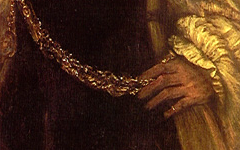Van Dyck’s Resurrection (c.1631-2)
Most commentary on this painting, and there has not been much in the past thirty years, addresses Van Dyck's style, the fluidity of his paint for instance, but not its content. Believed to have been painted for a private chapel or home, it is a scene of the Resurrection influenced by Rubens.1 What someone should have noticed, though, is that Christ has the long, dishevelled and reddish blond hair of the artist.
Click next thumbnail to continue

Left: Van Dyck, Detail of Self-portrait (1617-18)
Center: Detail of Van Dyck's Resurrection, rotated
Right: Van Dyck, Detail the artist from Portrait of Endymion Porter with the Artist (inverted)
Click image to enlarge.
If you compare Christ in the center to two self-portraits on either side, you will see that while the beard and moustache are different, the nose and eyebrows are similar, as is the parting of the hair to right of center. Identification with Christ would have sounded heretical to those who believed in Church dogma but to those in the Regular Church who followed the Inner Tradition it would have been quite natural for an artist as accomplished as Van Dyck to become Christ-like, identifying with all other figures in the painting too, at the creative moment.2
Click next thumbnail to continue
The figure below Christ is the "dreaming artist" who, divinely inspired, has "imagined" his painting of Christ above while the others marvel at its beauty. Van Dyck, it seems, has in part depicted the creative process inside his own mind and how, in shedding the illusive self we are all attached to, he has imagined his true Self, the one we are all thought to share with all of Nature, as the pure self of Christ.
Click next thumbnail to continue
It is normal for experts to provide documentation for a claim like this but there is no purpose here. The Inner Tradition, with its ultimate goal of identification with God, was available everywhere, hidden in allegory, for those who could think for themselves. You could find it in scripture, art, literature, the stories of saints' lives, the alchemist's laboratory, the cloister, monastery and chapel. With the Church itself in moral collapse there was no shortage of independent thinkers willing to question Church dogma and reinterpret the allegories of Scripture in line with their original intent: the Inner Tradition.
More Works by Van Dyck
A Van Dyck portrait at the Frick reveals some of its secrets easily

Van Dyck’s Marchesa Cattaneo (c.1622-7) at The Frick
Notes:
1. Eric Zafran (ed.), Renaissance to Rococo: Masterpieces from the Collection of the Wadsworth Atheneum Museum of Art (New Haven: Yale University Press) 2004, p. 112
2. Simon Abrahams, The Two Medieval Churches and Their Impact on Art (2011) at www.everypainterpaintshimself.com
Original Publication Date on EPPH: 25 Aug 2011. | Updated: 0. © Simon Abrahams. Articles on this site are the copyright of Simon Abrahams. To use copyrighted material in print or other media for purposes beyond 'fair use', you must obtain permission from the copyright owner. Websites may link to this page without permission (please do) but may not reproduce the material on their own site without crediting Simon Abrahams and EPPH.





